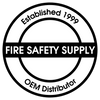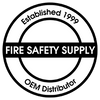Choosing the Right Fire Extinguisher for Your Home
Posted by the FSS Team on Sep 26th 2024
Fire safety isn't just a concern for businesses; it's equally important to keep your home protected. At
Fire Safety Supply, while we work closely with businesses to provide comprehensive fire safety solutions, we often receive a common question from homeowners: "What type of fire extinguisher do you recommend for my home?"
Choosing the right fire extinguisher for your home is crucial because it ensures you're prepared to tackle small fires before they escalate into something more dangerous. Let’s dive into the essentials of home fire extinguishers, their types, and the best options for your needs.
Understanding Fire Extinguisher Types
Before recommending a specific fire extinguisher for home use, it's important to understand the different types available. Each extinguisher is designed to combat certain types of fires, categorized into classes:
- Class A: For ordinary combustibles such as wood, paper, cloth, and plastics.
- Class B: For flammable liquids like grease, gasoline, oil, and oil-based paints.
- Class C: For electrical fires involving appliances, wiring, circuit breakers, and outlets.
- Class D: For flammable metals, which are less common in residential settings.
- Class K: Specifically for cooking fires involving oils and fats, common in kitchens.
Overall, our team recommends A, B, or C type of fire extinguishers. A 5lb would be a good size for a standard home.
Amerex - B500 5lb ABC Dry Chemical Extinguisher »
Ansul Sentry 442257 5 lb. FORAY Extinguisher »
For most households, a multi-purpose fire extinguisher that covers Class A, B, and C fires is ideal. This type of extinguisher can handle the majority of fire hazards you’re likely to encounter at home.
Key Features to Look for in a Home Fire Extinguisher
When selecting a fire extinguisher for your home, keep these essential features in mind:
1. Ease of Use:
Home extinguishers should be simple to operate. In a stressful situation, an easy-to-understand, user-friendly extinguisher is vital.
2. Size and Weight: A 5-pound extinguisher is generally suitable for most homes—light enough to handle easily but still effective for typical household fires.
3. Rechargeable vs. Disposable: Rechargeable extinguishers can be reused after servicing, making them a cost-effective long-term choice. Disposable ones are less expensive upfront but need replacing after one use.
4. Clear Labeling: Ensure the extinguisher has clear instructions and visible gauges to check its readiness.
5. Mounting Bracket:
Look for extinguishers that come with a mounting bracket for easy access. Placing them in key locations like the kitchen, garage, or near exit doors can save precious seconds during an emergency.
Where to Place Fire Extinguishers in Your Home
Strategically placing fire extinguishers around your home is as important as choosing the right type. Here are some recommended spots:
- Kitchen:
The kitchen is the most common area for household fires, usually caused by cooking mishaps. Place an extinguisher within easy reach, but not directly next to the stove, where it could be hard to access in a fire.
- Garage or Workshop:
These areas often contain flammable materials, making them a high-risk zone. Keep an extinguisher nearby in case of chemical, oil, or electrical fires.
- Laundry Room: Faulty appliances or electrical fires can start here, so having an extinguisher on hand can prevent these fires from spreading.
- Basement: If you have a furnace, fireplace, or other equipment, having a fire extinguisher nearby is a smart safety measure.
Maintaining Your Fire Extinguisher
Owning a fire extinguisher is a great first step, but regular maintenance ensures it's ready when you need it. Here are some tips:
- Inspect Monthly:
Check that the extinguisher is in its designated place, has not been tampered with, and has no visible damage. Ensure the pressure gauge needle is in the green zone.
- Recharge After Use:
Even if it’s only partially used, rechargeable extinguishers must be serviced to ensure they’re fully operational for future use.
- Replace When Needed: Disposable extinguishers need to be replaced after use or when they reach the end of their service life (usually 5-15 years).
Having a fire extinguisher in your home is a critical component of your overall fire safety strategy. While we specialize in helping businesses with advanced fire safety solutions, we understand the importance of safeguarding your home and loved ones as well. The right extinguisher can provide peace of mind and potentially save lives.
If you have any questions about fire extinguishers for your home or need guidance on choosing the best option, feel free to contact Fire Safety Supply. Our team is here to help you make informed decisions about your fire safety needs.
 Since 1999, Fire Safety Supply has been the go-to for fire suppression products, industrial dry chemical systems, high and low-pressure CO2, vehicles, and clean agents. We serve various types of industries such as restaurants, commercial kitchen, wineries, and more.
Since 1999, Fire Safety Supply has been the go-to for fire suppression products, industrial dry chemical systems, high and low-pressure CO2, vehicles, and clean agents. We serve various types of industries such as restaurants, commercial kitchen, wineries, and more.
